Android 低功耗蓝牙开发 (扫描过滤自定义服务与特性)Kotlin版
Posted 初学者-Study
tags:
篇首语:本文由小常识网(cha138.com)小编为大家整理,主要介绍了Android 低功耗蓝牙开发 (扫描过滤自定义服务与特性)Kotlin版相关的知识,希望对你有一定的参考价值。
扫描过滤、自定义服务与特性
前言
之前写过Kotlin版的低功耗蓝牙的扫描连接交互的文章,后面我在实践过程了也发现了一些问题,那就是当我从一个设备换到另一个设备时,需要去改动代码才行,这无疑给调试带了很大的困扰,因此我想对这个App做进一步的优化,有可能会做成一个低功耗蓝牙的通用调试App,最好能满足所有的调试需求,当然这是我的一个想法,下面开始吧。
正文
毫无疑问,这也是一个续作,想要结果的直接滑动到底部看源码即可,想了解具体过程的,可以先看看上一篇:Android 低功耗蓝牙开发(扫描、连接、数据交互)Kotlin版,好了下面就不说废话了,开始吧!
一、扫描过滤
首先看看扫描过滤的实现,先说说这个功能的使用场景,当附近蓝牙设备很多时,快速找到想要连接调试的设备,这是这个功能的初衷,同时在扫描蓝牙时可以过滤掉一些没有名字的设备,信号强度低的设备,或指定设备地址的设备,这才调试过程中都是比较常见的需求,因此我们一步一步的来实现这些功能需求。
① 页面设计
在添加功能的同时要考虑页面的合理和UI美化,不能说怎么简单怎么来,对自己要有要求,首先看看之前的扫描页面
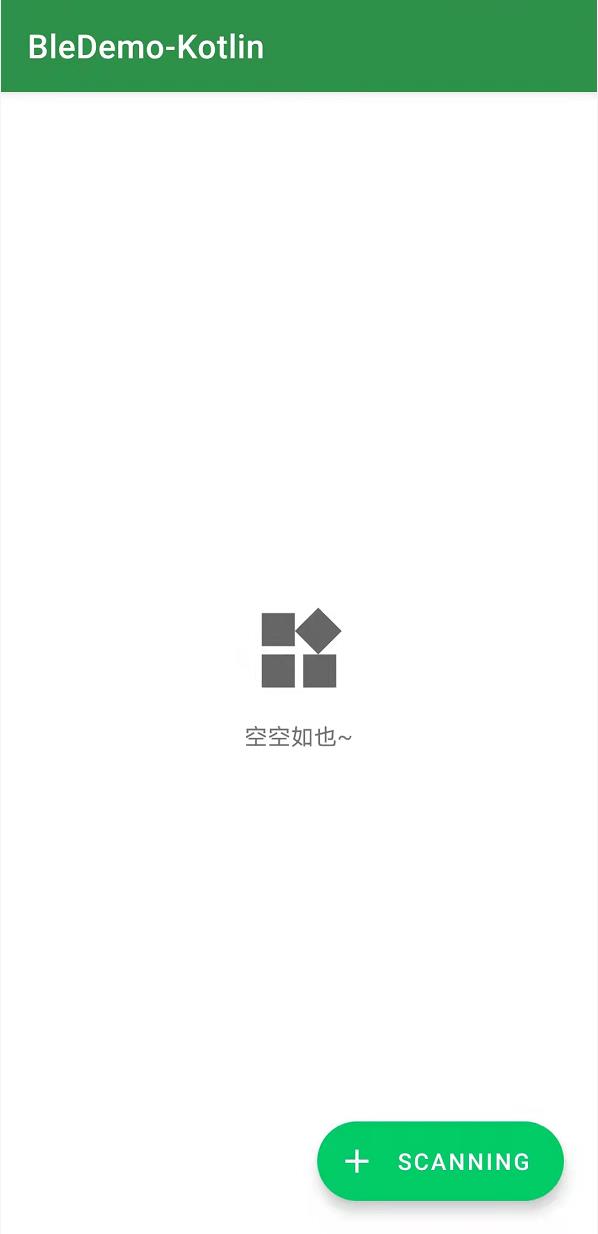
首先页面上很空旷,那么我们增加功能可以使用隐藏的方式,例如加一个菜单,右上角加三个点,同时我们把底部浮动按钮的文字改一下,改成开始扫描,这就补贴图说明了,直接在activity_main.xml中改动就可以了。
② 添加菜单
下面在页面上添加一个菜单用来作为页面其他功能的入口。首先在res下新建一个menu文件夹,然后在menu文件夹下新建一个main_menu.xml文件。
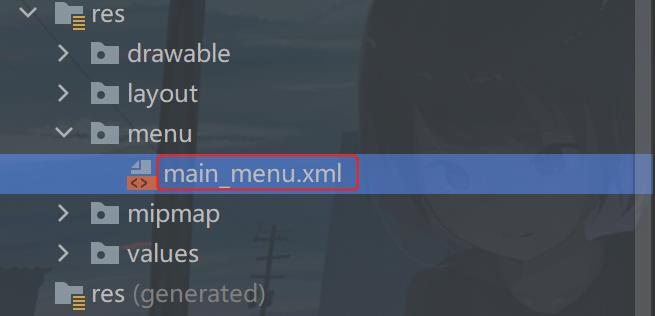
里面的代码如下:
<?xml version="1.0" encoding="utf-8"?>
<menu xmlns:android="http://schemas.android.com/apk/res/android"
xmlns:app="http://schemas.android.com/apk/res-auto"
xmlns:tools="http://schemas.android.com/tools">
<item
android:id="@+id/item_scan_filter"
android:title="扫描过滤"
app:showAsAction="never"
tools:ignore="HardcodedText" />
</menu>
然后回到MainActivity中,重写两个方法,如下:
/**
* 创建菜单
*/
override fun onCreateOptionsMenu(menu: Menu): Boolean
menuInflater.inflate(R.menu.main_menu,menu)
return true
/**
* 菜单点击
*/
override fun onOptionsItemSelected(item: MenuItem): Boolean
when (item.itemId)
R.id.item_scan_filter -> showMsg("扫描过滤")
else -> showMsg("Do nothing...")
return true
然后运行一下:
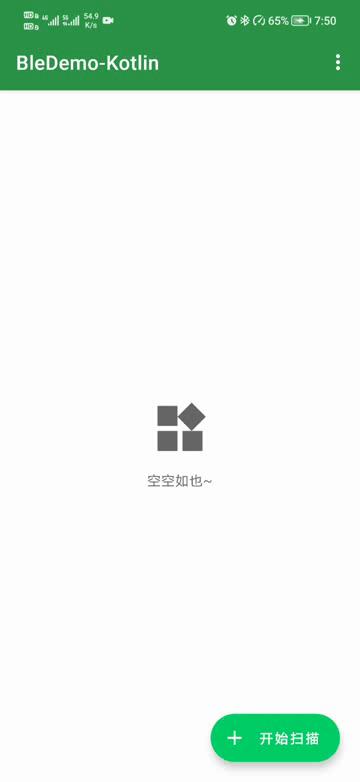
这都是很简单的操作了,是吧,下面我们来写一个用于设置过滤内容的弹窗。
③ 过滤设置弹窗
说到弹窗最简单的方式就是使用Android自带的弹窗,我比较喜欢用底部弹窗BottomSheetDialog,基本满足需求就不需要自己去自定义了。
首先在colors.xml中增加一个颜色,是分割线的颜色
<color name="line">#EEE</color>
然后通过drawable绘制一个顶部左右圆角的背景,在drawable下新建一个shape_white_top_radius_24.xml文件,代码如下:
<?xml version="1.0" encoding="utf-8"?>
<shape xmlns:android="http://schemas.android.com/apk/res/android">
<solid android:color="@color/white" />
<corners
android:topLeftRadius="24dp"
android:topRightRadius="24dp" />
</shape>
下面在layout下新建一个dialog_scan_filter.xml文件,代码如下:
<?xml version="1.0" encoding="utf-8"?>
<LinearLayout xmlns:android="http://schemas.android.com/apk/res/android"
xmlns:app="http://schemas.android.com/apk/res-auto"
xmlns:tools="http://schemas.android.com/tools"
android:layout_width="match_parent"
android:layout_height="wrap_content"
android:background="@drawable/shape_white_top_radius_24"
android:orientation="vertical">
<TextView
android:layout_width="match_parent"
android:layout_height="60dp"
android:gravity="center"
android:text="扫描过滤"
android:textColor="@color/black"
android:textSize="16sp" />
<View
android:layout_width="match_parent"
android:layout_height="0.5dp"
android:background="@color/line" />
<RelativeLayout
android:layout_width="match_parent"
android:layout_height="60dp"
android:orientation="horizontal"
android:padding="16dp">
<TextView
android:layout_width="wrap_content"
android:layout_height="wrap_content"
android:layout_centerVertical="true"
android:text="过滤设备名为空的设备"
android:textColor="@color/black" />
<androidx.appcompat.widget.SwitchCompat
android:id="@+id/switch_device_name"
android:layout_width="wrap_content"
android:layout_height="wrap_content"
android:layout_alignParentEnd="true"
android:theme="@style/SwitchStyle"
tools:ignore="UseSwitchCompatOrMaterialXml" />
</RelativeLayout>
<View
android:layout_width="match_parent"
android:layout_height="0.5dp"
android:background="@color/line" />
<LinearLayout
android:layout_width="match_parent"
android:layout_height="60dp"
android:gravity="center_vertical"
android:orientation="horizontal"
android:padding="16dp">
<TextView
android:layout_width="wrap_content"
android:layout_height="wrap_content"
android:text="RSSI:"
android:textColor="@color/black" />
<androidx.appcompat.widget.AppCompatSeekBar
android:id="@+id/sb_rssi"
android:layout_width="0dp"
android:layout_height="wrap_content"
android:layout_marginStart="12dp"
android:layout_marginEnd="12dp"
android:layout_weight="1"
android:max="100"
android:min="40"
android:progress="100"
android:theme="@style/SeekBarStyle" />
<TextView
android:id="@+id/tv_rssi"
android:layout_width="wrap_content"
android:layout_height="wrap_content"
android:text="-100 dBm"
android:textColor="@color/black" />
</LinearLayout>
<View
android:layout_width="match_parent"
android:layout_height="0.5dp"
android:background="@color/line" />
<TextView
android:id="@+id/tv_close"
android:layout_width="match_parent"
android:layout_height="60dp"
android:foreground="?attr/selectableItemBackground"
android:gravity="center"
android:text="关闭"
android:textColor="@color/black" />
</LinearLayout>
在styles.xml中增加如下样式:
<style name="BottomSheetDialogStyle" parent="Theme.Design.BottomSheetDialog">
<item name="android:windowFrame">@null</item>
<item name="android:windowIsFloating">true</item>
<item name="android:windowIsTranslucent">true</item>
<item name="android:background">@android:color/transparent</item>
<item name="android:backgroundDimEnabled">true</item>
</style>
<style name="SwitchStyle" parent="Theme.AppCompat.Light">
<!--开启时的颜色-->
<item name="colorControlActivated">@color/green_light</item>
<!--关闭时的颜色-->
<item name="colorSwitchThumbNormal">@color/gray_light</item>
<!--关闭时的轨迹颜色-->
<item name="android:colorForeground">@color/gray_dark</item>
</style>
<style name="SeekBarStyle" parent="Widget.AppCompat.SeekBar">
<item name="colorAccent">@color/green_light</item>
</style>
布局有了,下面进入MainActivity中写代码。增加一个方法:
/**
* 显示扫描过滤弹窗
*/
@SuppressLint("InflateParams")
private fun showScanFilterDialog() = BottomSheetDialog(this, R.style.BottomSheetDialogStyle).apply
setContentView(DialogScanFilterBinding.bind(View.inflate(context, R.layout.dialog_scan_filter, null)).apply
switchDeviceName.setOnCheckedChangeListener buttonView, isChecked ->
sbRssi.setOnSeekBarChangeListener(object : OnSeekBarChangeListener
override fun onProgressChanged(seekBar: SeekBar, progress: Int, fromUser: Boolean)
override fun onStartTrackingTouch(seekBar: SeekBar)
override fun onStopTrackingTouch(seekBar: SeekBar)
)
tvClose.setOnClickListener dismiss()
.root)
window?.findViewById<View>(R.id.design_bottom_sheet)?.setBackgroundColor(Color.TRANSPARENT)
.show()
这里面有一个开关一个滑动条,开关用于确定过滤设备名称为null的设备。首先来看这个开关,这里应该要保存开关的状态,每次每一次设置也是比较麻烦的,因此可以用一个本地缓存记录下来,通过也可以记录滑动条的位置,保存信号值强度。
④ 过滤设置缓存
写缓存会用到什么?上下文参数,那么就可以弄一个全局的上下文,怎么弄?自定义Application,在com.llw.blekotlin包下新建一个BleApplication类,代码如下:
open class BleApplication : Application()
companion object
@SuppressLint("StaticFieldLeak")
lateinit var context: Context
override fun onCreate()
super.onCreate()
context = applicationContext
很简单的代码,目前来说只有一个上下文,然后我们在AndroidManifest.xml中的application标签中去配置一下。

然后在utils包下新增一个扩展类,用于根据不同的数据类型进行缓存处理。实际上就是一个Kotlin文件,代码如下:
const val NAME = "config"
@SuppressLint("StaticFieldLeak")
val context = BleApplication.context
val sp: SharedPreferences = context.getSharedPreferences(NAME, Context.MODE_PRIVATE)
fun Boolean.putBoolean(key: String) = sp.edit().putBoolean(key, this).apply()
fun getBoolean(key: String, result: Boolean = false): Boolean = sp.getBoolean(key, result)
fun String?.putString(key: String) = sp.edit().putString(key, this).apply()
fun getString(key: String, result: String? = null): String? = sp.getString(key, result)
fun Int.putInt(key: String) = sp.edit().putInt(key, this).apply()
fun getInt(key: String, result: Int = 0): Int = sp.getInt(key, result)
fun Long.putLong(key: String) = sp.edit().putLong(key, this).apply()
fun getLong(key: String, result: Long = 0): Long = sp.getLong(key, result)
然后我将包名整理一下:目前的项目目录如下图所示:
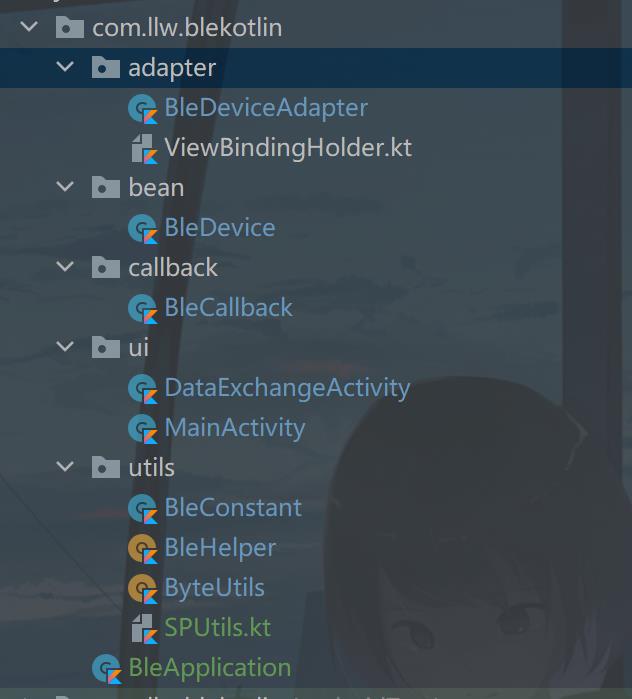
应该很清晰吧,下面进行操作,首先是保存记录,因此我需要弄两个常量,就在BleConstant中增加好了。增加如下代码:
/**
* 是否过滤设备名称为Null的设备
*/
const val NULL_NAME = "nullName"
/**
* 过滤信号强度值
*/
const val RSSI = "rssi"
下面回到MainActivity中,首先是对变量的控制,缓存数据也就两种操作方式,存和取。作为一个开关值那么就是true和false。当没有这个缓存的时候默认为false。当然也可以是true,根据实际需求来。那么这个缓存值的设置就在弹窗中的swich的操作时改变。代码如下:
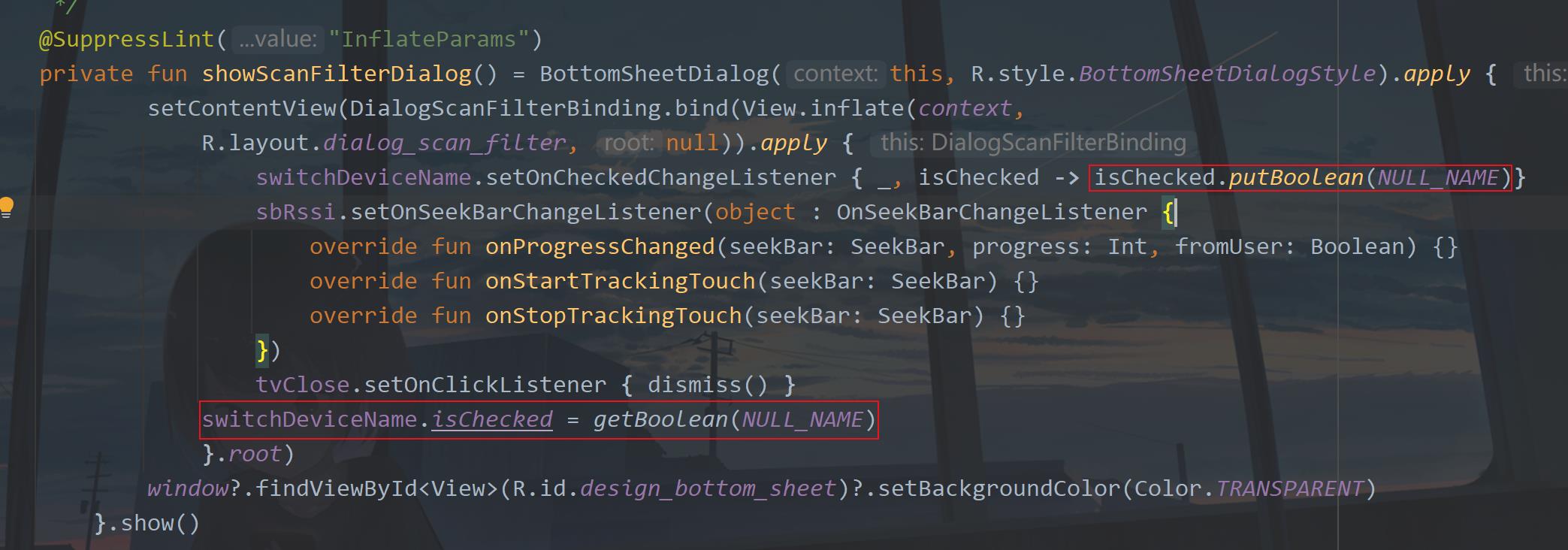
上图中有两处地方用到了这个常量值NULL_NAME,一个是存一个是取,这里还只是针对于弹窗中的设置和显示效果的不同,还没有对实际的扫描结果进行处理的,这个代码应该是很好理解的。下面是RSSI的值的存取。代码如下图所示:

这里当拖动Seekbar时,改变TextView显示的内容,当拖动结束时保存进度值到缓存中,然后处理弹窗这个窗时的页面显示状态,我这里通过getInt(RSSI,100)去获取本地的缓存,如果没有就设置为100,在扩展函数中我设置的缺省值是0,你也可以设置为100,则使用的地方就不需要增加这个默认参数了。例如我上次滑动到50,然后我关闭了弹窗,当我再次打开弹窗时应该也是要显示50的,那么对于本地缓存ui的控制效果演示图如下图所示:
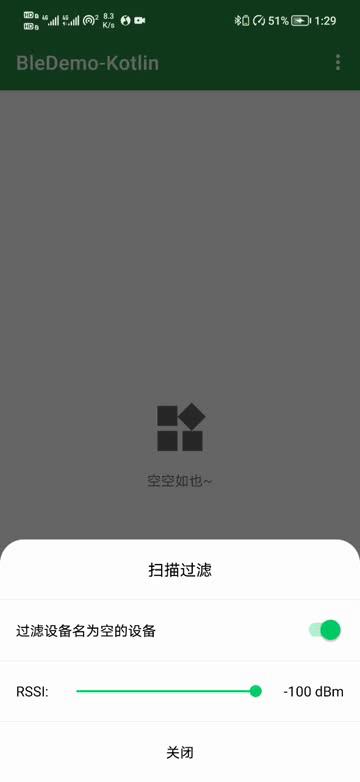
下面就可以对扫描到的设备进行操作了,因为扫描过滤的设置已经没有问题了,开发时要注意的细节很多。
⑤ 扫描设备过滤
开发是循序渐进的,逻辑很重要,先想清楚逻辑再进行编码这会让你事倍功半。下面就是对扫描的结果进行处理,针对于一些结果可以不用添加到设备列表中,因此就不会显示了。这里需要两个临时变量去控制。在MainActivity中增加如下代码:
//当前扫描设备是否过滤设备名称为Null的设备
private var isScanNullNameDevice = false
//当前扫描设备是否过滤设备信号值强度低于目标值的设备
private var rssi = -100
然后对扫描到的设备进行处理

然后是addDeviceList中的代码修改。
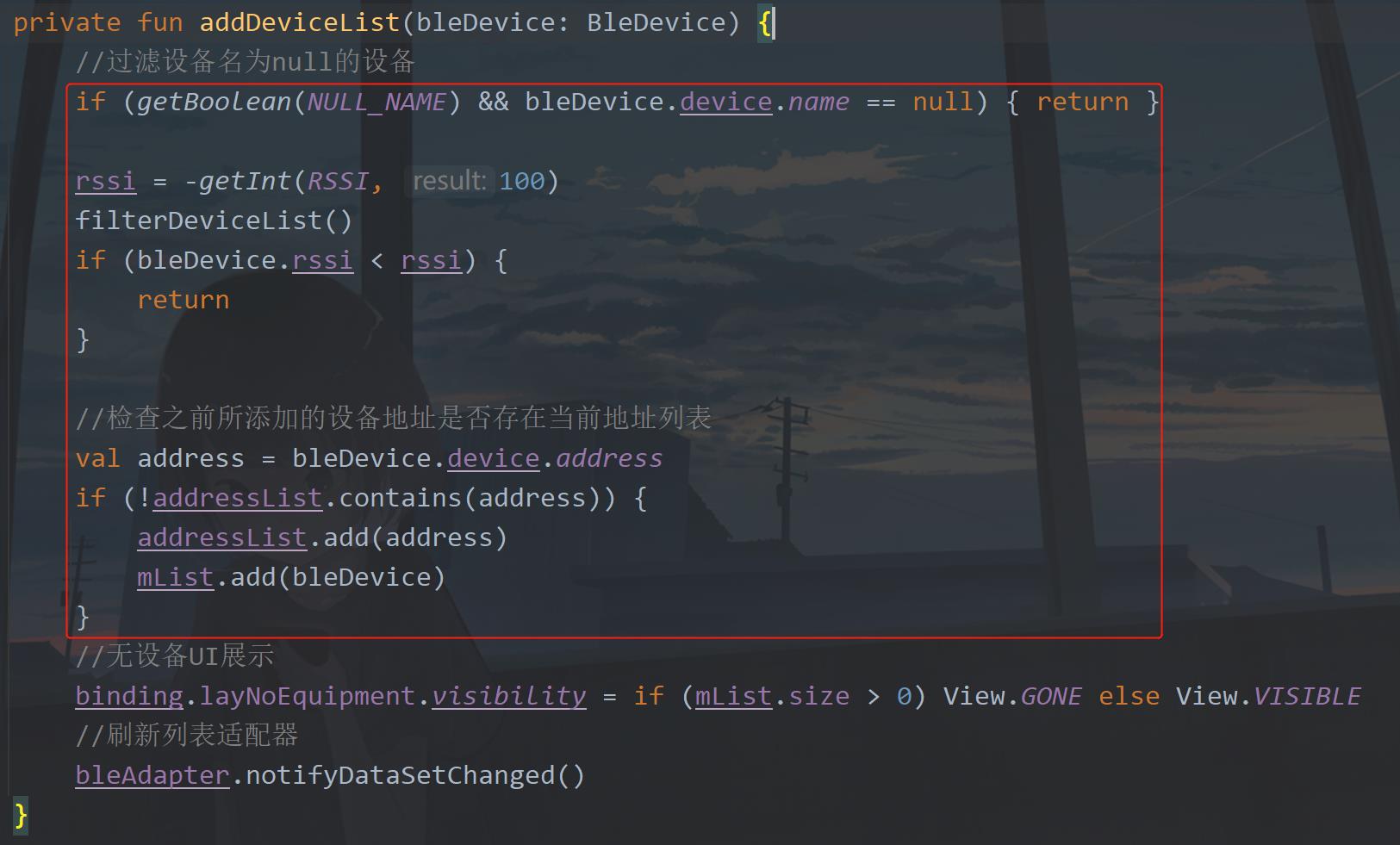
这里的代码就是对修改了扫描过滤中数据的处理,然后就是过滤设备列表,这里是一个方法,代码如下:
/**
* 过滤设备列表
*/
private fun filterDeviceList()
if (mList.size > 0)
val mIterator = mList.iterator()
while (mIterator.hasNext())
val next = mIterator.next()
if ((getBoolean(NULL_NAME) && next.device.name == null) || next.rssi < rssi)
addressList.remove(next.device.address)
mIterator.remove()
bleAdapter.notifyDataSetChanged()
通过迭代的方式对符合清除条件的设备进行移除,同时也要移除地址列表中的地址。
下面运行一下:
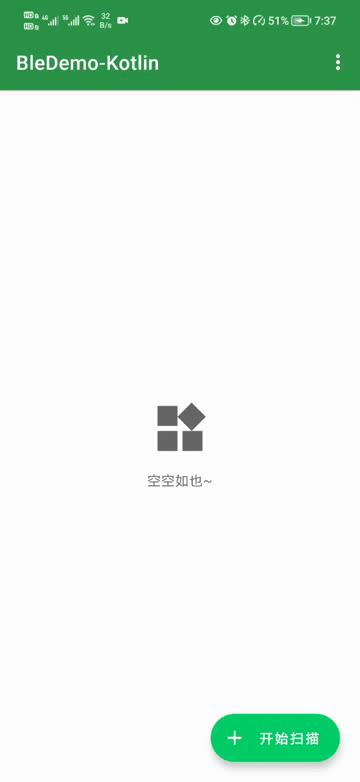
二、自定义服务与特性
这个功能的出发点就在于,当需要操作不同的低功耗蓝牙设备时,对应的设备需要使用对应的服务UUID和特性UUID,因此需要自定义这个服务与特性,做成可以动态设置的,这里依然采用弹窗来设置服务与特性。
① 弹窗设置
首先在layout下新增一个dialog_uuid_edit.xml,布局代码如下:
<?xml version="1.0" encoding="utf-8"?>
<LinearLayout xmlns:android="http://schemas.android.com/apk/res/android"
android:orientation="vertical"
android:layout_width="match以上是关于Android 低功耗蓝牙开发 (扫描过滤自定义服务与特性)Kotlin版的主要内容,如果未能解决你的问题,请参考以下文章
Qt低功耗蓝牙系列三(低功耗蓝牙客户端的程序设计纯Android代码)